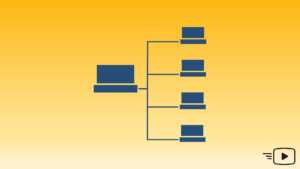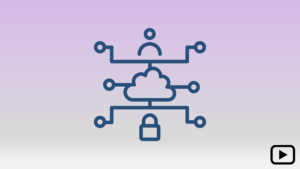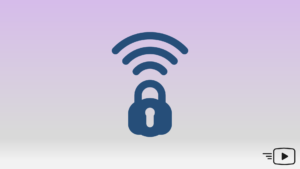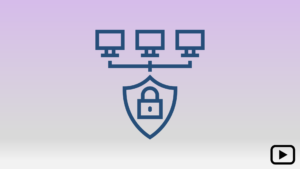
Troubleshooting Layer 2 Connectivity in PRI Configuration
This short video walks through how to troubleshoot a layer 2 connectivity error in a PRI configuration. This video is a small portion of the

CCNA Composite Lab Build Part 7
In Jim Goughenour’s 7th Installment of the Composite Lab Build, we dive a little deeper into EtherChannel, and take a look at how this improves

CCNA Mock Exam: Question 10
This video presents Question 10 of the CCNA mock exam: What standard is used in close conjunction with Wi-Fi? This video is a small portion

CCNA Mock Exam: Question 9
This video presents Question 9 of the CCNA mock exam: In a topology where there are four redundantly connected switches, which of the provided answers

CCNA Mock Exam: Question 8
This video presents Question 8 of the CCNA mock exam: What IOS command is used to create a static NAT between an inside local IP

CCNA Mock Exam: Question 7
This video presents Question 7 of the CCNA mock exam: What is the purpose of OSPF hello packets? This video is a small portion of

CCNA Mock Exam: Question 6
This video presents Question 6 of the CCNA mock exam: Based on an OSPF route entry from a routing table, what is the metric calculation?

CCNA Mock Exam: Question 5
This video presents Question 5 of the CCNA mock exam: What criteria does a router use to determine how to populate the routing table and

CCNA Mock Exam: Question 4
This video presents Question 4 of the CCNA mock exam: What is the only VLAN type permitted on an access port where there is already

CCNA Mock Exam: Question 3
This video presents Question 3 of the CCNA mock exam: What are the three primary differences between TCP and UDP? This video is a small

CCNA Mock Exam: Question 2
This video presents Question 2 of the CCNA mock exam: What is the length of an IPv6 address? This video is a small portion of

CCNA Mock Exam: Question 1
This video presents Question 1 of the CCNA mock exam: What subnet mask enables at least 40 host IP addresses per subnet? This video is

CCNA Composite Lab Build Part 6
In Jim Goughenour’s 6th Installment of the Composite Lab Build, we take another look at Spanning Tree Protocol as it relates to EtherChannel, and set

Configuring Voice Translation Rules on a Voice Gateway
These slides were used to present the Configuring Voice Translation Rules on a Voice Gateway Tech Session. (Click below to view/download these slides)

Configuring Voice Translation Rules on a Voice Gateway
In this 1-hour Tech Session, Kevin Koeper goes through how to configure and test voice translation rules in a Cisco voice gateway. This session is

What is on the CCNA Exam?
In this Tech Session, Jim Goughenour answers the question, “So, what is actually on the CCNA exam?” In the first part of this session, you

Cisco Secure Hybrid Workforce Solutions
In this 45 minute session, Kenya Thomas explores how you can enable security everywhere so you can empower work anywhere. You’ll learn: How Cisco security

What’s the Difference Between Speed Dial, Abbreviated Dial, Fast Dial, and BLF?
By: Kevin Koeper Cisco has provided end users multiple ways to quickly dial numbers. This can be very useful if administrators know how to configure

Configuring and Troubleshooting a PRI in a Cisco Voice Gateway
These slides were used to present the Configuring and Troubleshooting a PRI in a Cisco Voice Gateway Tech Session. (Click below to view/download these slides)

Configuring and Troubleshooting a PRI in a Cisco Voice Gateway
In this 1-hour Tech Session, Kevin Koeper goes through setting up an H.323 voice gateway with PRI connectivity to the PSTN. He then looks at

Analyzing Quality of Service Issues in Voice Networks
These slides were used to present the Analyzing Quality of Service Issues in Voice Networks Tech Session. (Click below to view/download these slides)

Analyzing Quality of Service Issues in Voice Networks
This Tech Session is part of the CLCOR study series. In this 1-hour Tech Session Kevin Koeper looks at the need for QoS in a

In-Office. At Home. On Guard with Meraki.
In this 45 minute session, Edwin Owen explores how Meraki solutions can empower collaboration and foster connection across distributed employees. You’ll learn: About Meraki and

IP Phone Security Features
This video lists the various security features found on IP phones including signed firmware images, secure boot, encrypted config files, and more. This video is

Multi-Layered Security
This video outlines the three layers of security: Secure Servers, Secure Endpoints, and Secure Network. This video is a small portion of the Collaboration Security

Phone Security Modes
This short video outlines the three phone security modes (non-secure, authenticated, and encrypted) and explains how they work. This video is a small portion of

Secure Physical Access
This brief video talks about the first line of defense, physical access, and actions that can be taken to prevent a breach. This video is

CUCM Secure Protocols
This short video discusses secure protocols used with Cisco Unified Communications Manager (CUCM) including SIP trunks, MGCP, H.323, and others. This video is a small

Signaling Secure to Non-Secure Interworking
This short video explains how to handle connection between one phone that is setup for encryption and a second phone that is non-secured. This video

TLS Session Establishment
This brief video outlines the process of TLS establishing a secure session between client and server. This video is a small portion of the Collaboration

TLS v1.2 Overview
This brief video provides an overview of TLS v1.2 comparing it to previous versions and outlining supported products. This video is a small portion of

Debugging Dial Peers
This video outlines how to enable debugging on SIP calls and PRI calls and what the debugging process looks like. This video is a small

Sample Dial Peer Configuration
This short video walks through sample dial peers for CUBE. This video is a small portion of the Configuring and Troubleshooting Dial Peers on a

Verifying Dial Peers
This short video explains how to determine which dial peer is being used through a series of commands. This video is a small portion of

VoIP Dial Peer Configuration
This video walks you through configuring VoIP Dial Peer Configuration from defining the next hop to setting the codec on the dial peer. This video

Debugging a PRI Call
This short video explains how to debug a PRI call and how to turn off debugging when you are done. This video is a small

Configuring Dial Peers
This brief video walks you through the steps needed to configure a dial peer in dial peer configuration mode. This video is a small portion

Dial Peer Variable Examples
This short video goes through seven dial peer variable examples. This video is a small portion of the Configuring and Troubleshooting Dial Peers on a

VoIP Dial Peer Digit Manipulation
This short video goes through a series of examples that outline digit manipulation in VoIP dial peer. This video is a small portion of the

What Does a Dial Peer Do?
This brief video explains how dial peers route calls for H.323 and SIP voice gateways and connects an incoming call leg to an outgoing call

Dial Peer Variables
This short video outlines the dial peer digits and variables that can be assigned to the dial peer. This video is a small portion of

Configuring Cisco Unified Border Element (CUBE)
This video walks you through the steps to configure CUBE from allowing sip to sip connections to creating inbound and outbound dial peers. This video

Debugging an SDP Gateway
This short video covers how to enable debugging for an SDP gateway and walks through a sample invite message. This video is a small portion

SIP Delayed Offer
This brief video introduces SIP Delayed Offer in which the called party sends the SDP offer information in the 200 OK message. This video is

SIP Early Offer
This short video introduces SIP Early Offer in which the originator sends the SDP offer information in the first message. This video is a small

SIP Call Flow
This brief video takes a closer look at the packets being sent in the SIP call flow. This video is a small portion of the

Using SIP Options Ping as a Keep Alive
This brief video explains why using SIP Options Ping is recommended as a Keep Alive and how it works with CUCM. This video is a

Configuring a SIP Trunk in CUCM
This short video walks you through how to configure an SIP trunk in CUCM including fields such as Significant Digits, Calling Search Space, SIP Trunk

Understanding SDP (Session Description Protocol)
This short video explains what SDP (Session Description Protocol) is and walks through the SDP Offer and the SDP Answer. This video is a small

Cisco Phone Troubleshooting: Phone not Registering
This brief video explains how to troubleshoot a Cisco Phone that does not register using the ‘shutdown’ and ‘no shutdown’ commands. This video is a

Collaboration Security Concepts
These slides were used to present the Collaboration Security Concepts Tech Session. (Click below to view/download these slides)

Collaboration Security Concepts
Collaboration security is more than toll fraud prevention. In this 1-hour webinar, Toby Sauer covers the areas of Collaboration that should be addressed to fully

CCNA Composite Lab Build Part 5
In Jim Goughenour’s 5th Installment of the Composite Lab Build, we start to segment our LAN architecture by adding some VLANs and some inter-VLAN routing.

Configuring and Troubleshooting Dial Peers on a Voice Gateway
These slides were used to present the Configuring and Troubleshooting Dial Peers on a Voice Gateway Tech Session. (Click below to view/download these slides)

Configuring and Troubleshooting Dial Peers on a Voice Gateway
This webinar is part of the CLCOR study series. In this session, Kevin Koeper, goes over how to configure Dial Peers in a voice gateway

Versions of SNMP
This video walks you through the three versions of SNMP: SNMP v1, SNMP v2, and SNMP v3, and outlines the differences between them. This video

The Three Planes – Review
This short video reviews the three planes: Management, Control, and Data, and provides examples of each. This video is a small portion of the Secure

The Pyramid of Planes
This brief video outlines The Pyramid of Planes consisting of (top to bottom) the Data Plane, the Control Plane, the Management Plane, and Physical Security.

Secure Syslog Architecture
This video breaks down the Secure Syslog architecture into its’ runtime components, functions, and format. This video is a small portion of the Secure Network

Components, Capabilities, and Benefits of Secure Logging
This short video outlines the components, capabilities, and benefits of Secure Logging. This video is a small portion of the Secure Network Management: Logs and

System Logging Protocols and Ports
This video outlines the three ways to provide system logging including UDP/514, TLS/6514, and NSEL. This video is a small portion of the Secure Network

NTP Architecture
This short video breaks down the components, commands, ports and protocols that make up Network Time Protocol (NTP). This video is a small portion of

Configuring NTP Demo
This demo walks you through how to configure Network Time Protocol (NTP). This video is a small portion of the Secure Network Management: Logs and

Configuring Secure Syslog Demo
This demo walks you through how to configure Secure Syslog. This video is a small portion of the Secure Network Management: Logs and Time Tech

Configuring SNMP Demo
This demo walks you through how to configure SNMP v3. This video is a small portion of the Secure Network Management: Logs and Time Tech

Components, Capabilities, and Benefits of SNMP
This short video explains the components, capabilities, and benefits of Simple Network Management Protocol (SNMP). This video is a small portion of the Secure Network

Components, Capabilities, and Benefits of NTP
This short video explains the components, capabilities, and benefits of Network Time Protocol (NTP). This video is a small portion of the Secure Network Management:

CCNA Composite Lab Build Part 4
In Jim Goughenour’s 4th Installment of the Composite Lab Build, we take a deeper look at IPv6 addressing, along with IPv6 static and default routing.

What’s the Difference Between Apply Config and Reset on a Cisco Phone?
By: Kevin Koeper If you have worked with Cisco phones for very long, you have probably noticed when configuring a phone in Communications Manager there

Remote Workforce Reimagined
In this 30 minute session, Edwin Owen and Kenya Thomas discuss the current remote work IT landscape and ways it can powerfully impact your business

Configuring and Troubleshooting an SIP Trunk
These slides were used to present the Configuring and Troubleshooting an SIP Trunk Tech Session. (Click below to view/download these slides)

Configuring and Troubleshooting an SIP Trunk
This webinar is part of the CLCOR study series. In this session Kevin Koeper goes over how to configure a SIP trunk in Communications Manager

Configuring the Switch Port
This video walks you through the all the steps necessary to configure a switch port from using the ‘configure terminal’ command to enter configuration mode

Determining Which Switch a Phone is Connected to
This video walks you through the steps to find out what switch port a specific phone is connected to including what settings must be enabled.

IP Phone Boot Up Process
This short video walks you through the IP Phone boot up process from powering on via PoE or a power brick to sending out a

Logging into a Switch
This brief video focuses on how to login to a switch, remotely, using telnet or SSH. This video is a small portion of the Configuring

Switch Configuration for Cisco Phones Summary
This brief video provides a helpful summary of key concepts related to Switch Configuration for Cisco Phones. This video is a small portion of the

Verifying the Switch Port Configuration
This video walks you through the steps necessary to verify that your switch is configured correctly. This video is a small portion of the Configuring

Secure Network Management: Logs and Time
These slides were used to present the Secure Network Management: Logs and Time Tech Session. (Click below to view/download these slides)

Secure Network Management: Logs and Time
In this 1-hour session, Eric Smith examines the why and how to secure the management of network devices. This will include SNMPv3, secure logging and

Configuring a Switch to Support Cisco Phones
These slides were used to present the Configuring a Switch to Support Cisco Phones Tech Session. (Click below to view/download these slides)

YANG Container
This short video explains what a YANG Container is and how it is used within a module. This video is a small portion of the

YANG Grouping
This short video explains what a YANG Grouping is and how it is used within a module. This video is a small portion of the

YANG Data Types
This short video outlines two common data types used in YANG: Built-in and Common (IETF YANG and IETF Inet). This video is a small portion

YANG Leaf-List
This short video explains what a YANG Leaf-List is and how it is used within a module. This video is a small portion of the

YANG Leaf
This short video explains what a YANG Leaf is and how it is used within a module. This video is a small portion of the

YANG List
This short video explains what a YANG List is and how it is used within a module. This video is a small portion of the

YANG Leafref
This short video explains what a YANG Leafref is and how it is used within a module. This video is a small portion of the

YANG Backward Compatibility
This brief video discusses the backward compatibility of YANG data modules and how it utilizes revision dates and status statements. This video is a small

YANG Syntax
This brief video breaks down the four main types of data nodes used in YANG modeling: Leaf, Leaf-List, List, and Container. This video is a

YANG Overview
This video provides an overview of what YANG (Yet Another Next Generation) is how it is used. This video is a small portion of the The Basics

YANG Structure
This short video breaks down the structure of a YANG file including elements such as Header Information, Revision Information, and Reusable Nodes Declaration. This video

YANG Modules/Submodules
This short video explains how to read a YANG data model and defines what a Modules and Submodules are. This video is a small portion

CCNA Composite Lab Build Part 3
In Jim Goughenour’s 3rd installment of the Composite Lab Build, we now take our Access and Distribution segments and layer in some Default and Internet

The Basics of YANG
Not sure what YANG is all about? Come join Edwin Owen for this 1-hour Tech Session to learn the basics of YANG. We’ll start with

The Basics of YANG
These slides were used to present the The Basics of YANG Tech Session. (Click below to view/download these slides)

CER Groups
This video explains what a CER Group is the maximum capacity of a Group in terms of IP phones, analog phones, LAN switches, and IP

Verifying VLANs and Power Usage
This short video explains how to verify VLANs and phone power usage using the ‘show vlan’ and ‘show power inline’ commands, respectively. This video is

CER Clusters
This brief video explains how CER Groups can be grouped together to form CER Clusters when there is a substantial amount of phones on a

Assigning Permissions to CER Users
This short video explains how to add CER users to a user group which contain a list of roles such as Emergency Responder System Admin
